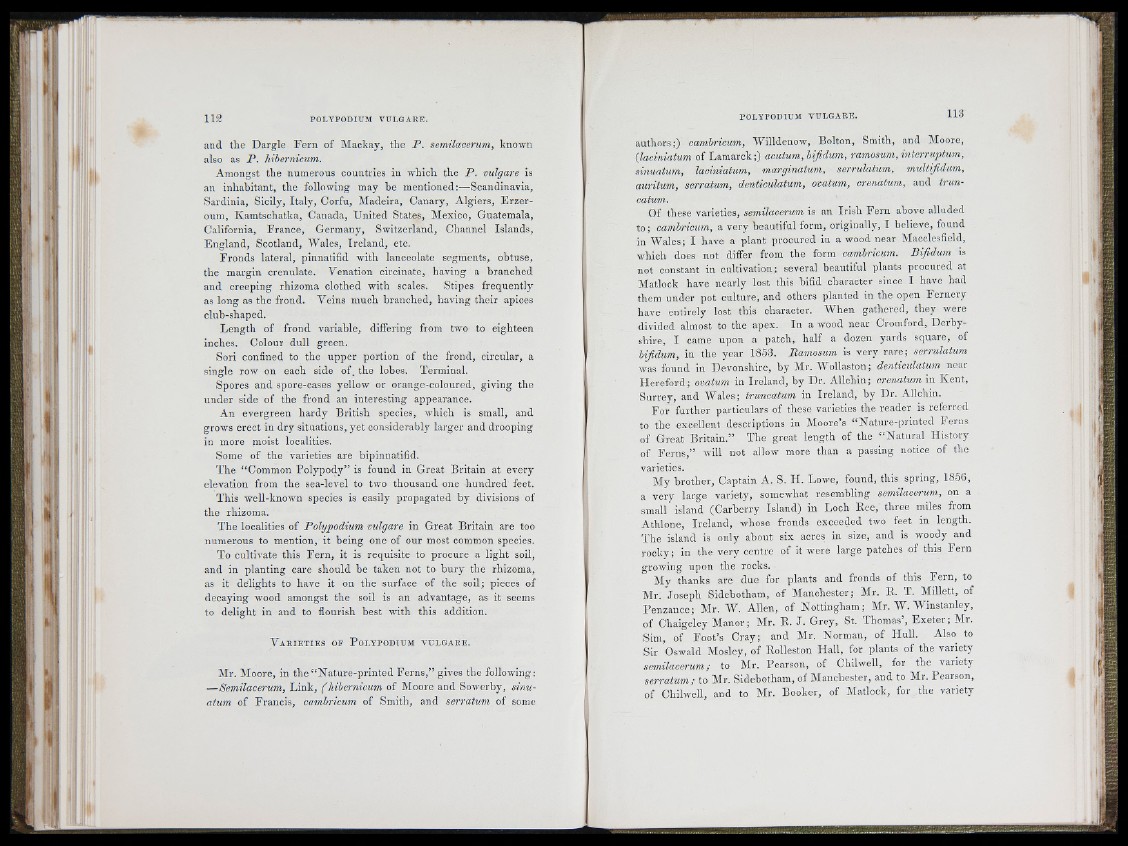
Alii
and the Dargle F e rn of Mackay, the P . semilacenim, known
also as P . hibernicum.
Amongst the numerous countries in which the P . m lg a re is
an inhabitant, the following may be mentioned:—Scandinavia,
Sardinia, Sicily, Ita ly , Corfu, Aladeira, Canary, Algiers, E rz e r-
oum, Kamtschatka, Canada, Un ited States, Mexico, Guatemala,
California, Fran c e , Germany, Switzerland, Channel Islands,
E n g lan d , Scotland, Wales, Ire la n d , etc.
Eronds lateral, pinnatifid with lanceolate segments, obtuse,
the margin crenulate. Venation circinate, having a branched
and creeping rhizoma clothed with scales. Stipes frequently
as long as the frond. Veins much branched, having th e ir apices
club-shaped.
L ength of frond variable, differing from two to eighteen
inches. Colour dull green.
Sori confined to the u p p e r portion of the frond, circular, a
single row on each side of. th e lobes. Terminal.
Spores and spore-cases yellow or orange-coloured, giving the
un d e r side of the frond an interesting appearance.
A n evergreen ha rd y British species, which is small, and
grows erect in dry situations, yet considerably la rg e r and drooping
in more moist localities.
Some of the varieties are bipinnatifid.
The “ Common P o ly p o d y ” is found in Great Britain at every
elevation from the sea-level to two thousand one hu n d red feet.
This well-known species is easily propagated b y divisions of
the rhizoma.
T h e localities of Polypodium mdgare in Great Britain are too
numerous to mention, it being one of our most common species.
To cultivate this E e rn , it is requisite to procure a lig h t soil,
and in planting care should be taken not to b u ry the rhizoma,
as it delights to have it on the surface of the soil; pieces of
decaying wood amongst the soil is an advantage, as it seems
to delight in and to flourish best with this addition.
V a r i e t i e s o f P o l y p o d i u m t u l g a r e .
■if
Air. Aloore, in the “ N a tu re -p rin ted F e rn s ,” gives the following:
— Semilacerum, L in k , (hibernicum of Aloore and Sowerby, sin u atum
of F rancis, cambricum of Smith, and serratum of some
authors;) cambricum, Willdenow, Bolton, Smith, and Aloore,
{laciniatum of L amarck;) acutum, bifidum, ramosum, interruptum,
sinuatum, laciniatum, marginatum, serrulatuin, multifidum,
auritum, serratum, denticulatum, ooatum, crenatum, and trun-
catum.
Of these varieties, semilacerum is an Irish F e rn above alluded
to ; cambrictim, a very beautiful form, originally, I believe, found
in Wales; I have a plant procured in a wood near Alacclesfield,
which does not differ from the form cambricum. B ifid um is
not constant in cultivation; several beautiful plants p rocured at
Alatlock have nearly lost this bifid character since I have had
them under pot culture, and others planted in the open F e rn e ry
have entirely lost this character. AVhen gathered, they were
divided almost to the apex. In a wood near Cromford, D e rb y shire,
I came upon a patch, h a lf a dozen yards square, of
bifidum, in the year 1853. Ramosum is very ra re ; serrulatum
was found in Devonshire, b y Air. AVollaston; denticulatum near
H e re fo rd ; ovatum in Ire lan d , h y D r. Allchin; crenatum in K en t,
S urrey, and AVales; truncatum in Ire lan d , by Dr. Allchm.
F o r furth e r particulars of these varieties the reader is refe rred
to the excellent descriptions in Aloore’s “ N a tu re -p rin ted F erns
of Great B rita in .” The great length of the “ N a tu ra l Histo ry
of F e rn s ,” will not allow more than a passing notice of the
varieties.
My b ro th e r. Captain A. S. H . Lowe, found, this spring, 1856,
a very large variety, somewhat resembling semilacerum, on a
small island (C a rb e rry Island) in Loch Kee, three miles from
Athlone, Ire la n d , whose fronds exceeded two feet in length.
T h e island is only about six acres in size, and is woody and
ro c k y ; in the very centre of it were large patches of this F e rn
growing upon the rocks.
Aly thanks are due for plants and fronds of this F e rn , to
Mr. Joseph Sidebotham, of Alanchester; Air. E . T. Alillett, of
Penz an c e ; Air. W . Allen, of Nottin g h am ; Air. AV. Winstanley,
of Chaigeley Alanor; Air. E . J . Grey, St. Thomas’, E x e te r; Air.
Sim, of F o o t’s Cray; and Air. Norman, of H u ll. Also to
Sir Oswald Mosley, of Kolleston H a ll, for plants of the variety
semilacerum; to Air. Pearson, of Chilwell, for the variety
se rra tum ; to Air. Sidebotham, of Alanchester, and to Mr. Pearson,
of Chilwell, and to Air. Booker, of Alatlock, for the variety